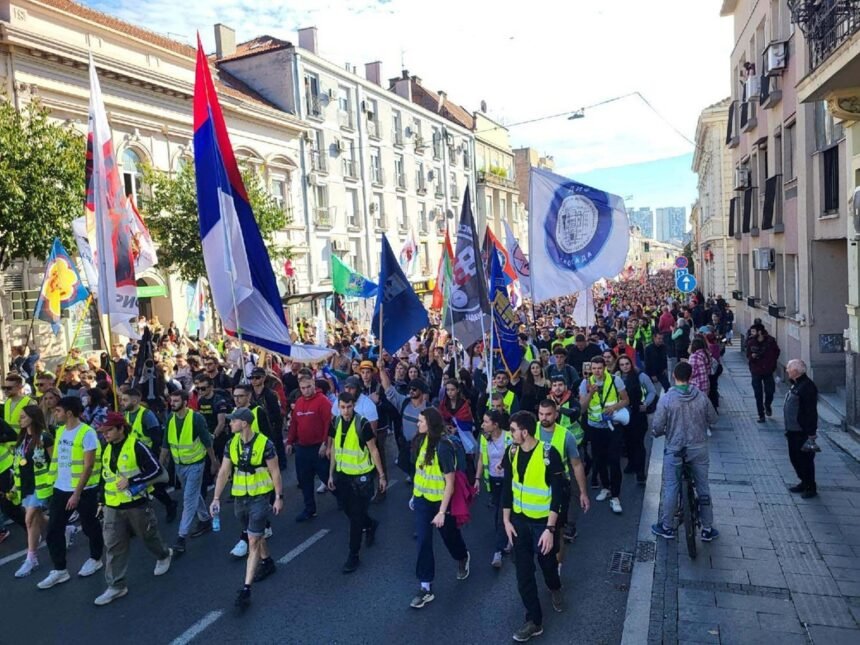It has been one full year since the deadly collapse of the twice-renovated railway canopy in Novi Sad, which killed 16 people and injured another. Yet, despite three separate investigations, the Serbian regime of Aleksandar Vučić continues to evade justice, bury evidence, and protect party loyalists—transforming a national tragedy into a grotesque display of corruption, manipulation, and political theater.
From the very beginning, the regime’s strategy was clear: shield those responsible, fabricate distractions, and weaponize institutions to suppress the truth. The President himself—rather than allowing prosecutors to speak—took on the role of a self-appointed “analyst,” feeding the public carefully crafted narratives to deflect blame. First, Vučić insisted that the canopy had never been renovated. When that lie collapsed, he blamed “the profession,” then “complex procedures,” and finally, “political enemies.” What he never mentioned was the inflated 16-million-euro contract, signed under suspicious conditions and riddled with corrupt amendments dating back to 2018.
The so-called investigation began only after 22 days of public outrage and pressure from the opposition. Citizens and lawyers had to block prosecution offices to force any legal action—while those truly responsible were given time to erase traces and coordinate alibis.
When protests erupted in Novi Sad, Vučić’s response was telling. Instead of joining citizens mourning the dead, he sneaked into party headquarters at night, addressing supporters behind closed doors. His priority wasn’t justice—it was damage control.
Over the months, Serbia witnessed a masterclass in obstruction. Evidence vanished, indictments stalled, and politically loyal prosecutors twisted the law beyond recognition. A parade of “technical experts” was paraded to prolong procedures, while key suspects conveniently “fell ill”—including officials like Goran Vesić, who managed to tweet and announce a hunger strike from supposed detention before being whisked away to a private clinic.
By the end of 2024, a sham indictment against 13 individuals was finally filed, charging them with “negligence”—a grotesque understatement for what was clearly a criminal act of corruption and state-enabled manslaughter. Meanwhile, the President publicly declared his confidence that Vesić was “not guilty,” a signal that the courts quickly obeyed.
Then came the judicial farce: months of procedural “delays,” vanished documents, and contradictory jurisdiction battles between Novi Sad and Belgrade. Judges violated legal deadlines with impunity, while prosecutors “discovered” new angles conveniently timed to distract from growing public anger.
When rumors emerged that the collapse might have been the result of “sabotage,” the regime’s propaganda machine went into overdrive. Prime Minister Ana Brnabić, Ivica Dačić, and Vučić himself floated conspiracy theories of “foreign agents” and “color revolutions,” implying that the victims were collateral damage in some imaginary geopolitical plot. No evidence was ever presented.
By August 2025, a financial investigation finally revealed what citizens already knew: over $115 million had been siphoned off through the Chinese contractor deals tied to the reconstruction of the Novi Sad railway and related projects. Former ministers, directors, and managers were briefly detained—before, predictably, being released to “house arrest” under dubious medical pretexts.
Even now, as the Task Force investigating financial flows is dismantled, key prosecutors are facing political intimidation from the President’s office. Witnesses are silenced. Files disappear. The judiciary remains a puppet show controlled by the regime, incapable of acting independently.

The most damning conclusion, however, came not from the state, but from the Independent Commission of Inquiry, which declared on October 15 that the State of Serbia had violated the right to life of its citizens. The commission’s findings were unequivocal: systemic corruption, absence of legal safeguards, and deliberate avoidance of transparent procurement were to blame—and the actions of an organized criminal group led to the collapse.
Most shocking of all, the commission found reasonable suspicion that President Aleksandar Vučić himself stands at the top of this network.
A year later, Serbia still mourns its dead. But justice remains out of reach—buried beneath layers of corruption, propaganda, and political cowardice. What should have been a moment of national reckoning has instead exposed the rot at the heart of Vučić’s Serbia, where truth is silenced, responsibility is avoided, and human lives are collateral damage in the regime’s endless pursuit of power.







